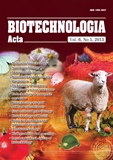ISSN 2410-776X (Online),
ISSN 2410-7751 (Print)

"Biotechnologia Acta" v. 6, no. 5, 2013
https://doi.org/10.15407/biotech6.05.100
Р.100-107, Bibliography 21, Ukrainian
Universal Decimal classification: 576.32/36; 57.085.23
EXPRESSION OF PLURIPOTENCY MARKERS IN REPROGRAMMING WITH TRANSPOSON SYSTEM MURINE FIBROBLASTS
S. V. Malysheva1, 2, N. M. Bilko1, J. Hescheler2
1National University of «Kyiv-Mohylanska Academy», Kyiv, Ukraine
2Institute of Neurophysiology, University of Cologne, Cologne, Germany
The search for effective and safe methods to generate induced pluripotent stem cells is especially urgent. In the paper murine embryonic fibro blasts were reprogrammed towards actively proliferating colonies with typical induced pluripotent stem cells morphology by means of Sleeping beauty transposon-based vector system. The obtained clones were checked for the expression of various pluripotency markers: alkaline phosphatase, Oct4 and Sox2 genes, SSEA-1 expression in various clones was evaluated. Also the reactivation of endogenous pluripotency factors Nanog and Rex1 was indicated. The data obtained is analyzed and compared to the established pluripotent stem cell line. It is shown that somatic cells are reprogrammed towards pluripotency by means of Sleeping beauty transposon system. Therefore, the system is a new perspective biotechnological tool to generate pluripotent cells.
Key words: induced pluripotent stem cells, reprogramming, pluripotency markers.
© Palladin Institute of Biochemistry of National Academy of Sciences of Ukraine, 2013
References
1. Takahashi K., Yamanaka S. Induction of pluripotent stem cells from mouse embryonic and adult fibroblast cultures by defined factors. Cell. 2006, V. 126, P. 663–676.
https://doi.org/10.1016/j.cell.2006.07.024
2. Takahashi K., Tanabe K., Ohnuki M. Induction of pluripotent stem cells from adult human fibroblasts by defined factors. Cell. 2007, V. 131, P. 861–872.
https://doi.org/10.1016/j.cell.2007.11.019
3. Ebben J. D., Zorniak M., Clark P. A. Introduction to induced pluripotent stem cells: advancing the potential for personalized medicine. World Neurosurg. 2011, V. 76, P. 270–275.
https://doi.org/10.1016/j.wneu.2010.12.055
4. Vitalea A. M., Wolvetangb E., Mackay-Sima A. Induced pluripotent stem cells: A new technology to study human diseases. Int. J. Biochem. Cell Biol. 2011, V. 43, P. 843–846.
https://doi.org/10.1016/j.biocel.2011.03.013
5. Ohm J. E., Mali P., van Neste L. Cancer-Related Epigenome Changes Associated with Reprogramming to Induced Pluripotent Stem Cells. Cancer Res. 2010, V. 70, P. 7662–7673.
https://doi.org/10.1158/0008-5472.CAN-10-1361
6. Sommer C. A., Stadtfeld M., Murphy G. J. Induced pluripotent stem cell generation using a single lentiviral stem cell cassette. Stem Cells. 2009, V. 27, P. 543–549.
https://doi.org/10.1634/stemcells.2008-1075
7. Zhou W., Freed C. R. Adenoviral gene delivery can reprogram human fibroblasts to induced pluripotent stem cells. Stem Cells. 2009, V. 27, P. 2667–2674.
https://doi.org/10.1002/stem.201
8. Okita K., Matsumura Y., Sato Y. A more efficient method to generate integration-free human iPS cells. Nat. Meth. 2011, V. 8, P. 40–412.
https://doi.org/10.1038/nmeth.1591
9. Plews J. R., Li J., Jones M. Activation of pluripotency genes in human fibroblast cells by a novel mRNA based approach. PLoS One. 2010, V. 5, e14397. doi: 10.1371/ journal.pone.0014397.
10. Jin J., Kwon Y. W., Paek J. S. Analysis of differential proteomes of induced pluripotent stem cells by protein-based reprogramming of fibroblasts. J. Proteome Res. 2011, V. 10, P. 977–989.
https://doi.org/10.1021/pr100624f
11. Meir Y. J., Wu S. C. Transposon-based vector systems for gene therapy clinical trials: challenges and considerations. Chang Gung Med. J. 2011, V. 34, P. 565–579.
12. Donnelly M. L., Hughes L. E., Luke G. The ‘cleavage’ activities of foot-and-mouth disease virus 2A site-directed mutants and naturally occurring ‘2A-like’ sequences. J. Gen. Virol. 2001, V. 82, P. 1027–1041.
https://doi.org/10.1099/0022-1317-82-5-1027
13. Naujok O., Kaldrack J., Taivankhuu T. Selective removal of undifferentiated embryonic stem cells from differentiation cultures through HSV1 thymidine kinase and ganciclovir treatment. Stem Cell Rev. 2010, V. 6, P. 450–461.
https://doi.org/10.1007/s12015-010-9148-z
14. Chen J., Liu J., Chen Y. Rational optimization of reprogramming culture conditions for the generation of induced pluripotent stem cells with ultra-high efficiency and fast kinetics. Cell Res. 2011, V. 21, P. 884–894.
https://doi.org/10.1038/cr.2011.51
15. Khodadadi K., Sumer H., Pashaiasl M. Induction of pluripotency in adult equine fibroblasts without c-MYC. J. Stem Cells Int. 2012, V. 2012: 429160.
https://doi.org/10.1155/2012/429160
16. Sterneckert J., H?ing S., Sch?ler H. R. Concise review: Oct4 and more: the reprogramming expressway. Stem Cells. 2012, V. 30, P. 15–21.
https://doi.org/10.1002/stem.765
17. Nemajerova A., Kim S. Y., Petrenko O. Two-factor reprogramming of somatic cells to pluripotent stem cells reveals partial functional redundancy of Sox2 and Klf4. Cell Death Differ. 2012, V. 19, P. 1268–1276.
https://doi.org/10.1038/cdd.2012.45
18. Wu T., Wang H., He J. Reprogramming of trophoblast stem cells into pluripotent stem cells. Stem Cells. 2011, V. 29, P. 755–763.
https://doi.org/10.1002/stem.617
19. Yuan X., Wan H., Zhao X. Combined chemical treatment enables Oct4-induced reprogramming from mouse embryonic fibroblasts. Stem Cells. 2011, 29 (3), 549–553.
https://doi.org/10.1002/stem.594
20. Page R. L., Ambady S., Holmes W. F. Induction of stem cell gene expression in adult human fibroblasts without transgenes. Stem Cells. 2009, V. 11, P. 417–426.
https://doi.org/10.1089/clo.2009.0015
21. Hatano S. Y., Tada M., Kimura H. Pluripotential competence of cells associated with Nanog activity. Mech. Dev. 2005, V. 122, P. 67–79.
https://doi.org/10.1016/j.mod.2004.08.008

